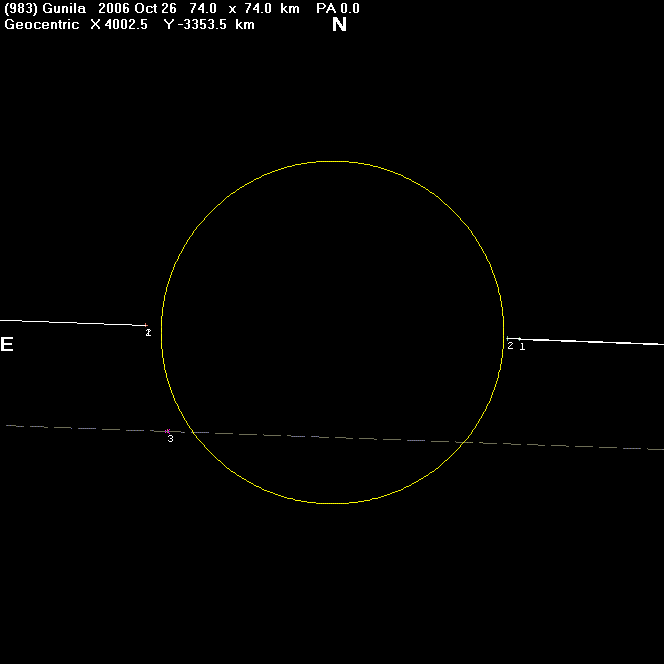A 3.2 second occultation was recorded by John Drummond, and 3.1 seconds by John Burt, both at the Possum Observatory, Gisborne, NZ, using visual observation. They used two similar sized telescopes about 10 meters apart.
View the updated prediction.
Observers: 1 J Drummond, Possum Observeratory, Gisborne, New Zealand 2 J Burt, Possum Observeratory, Gisborne, New Zealand

Discussion:
The circle above is plotted at the expected 74km diameter of Gunila. With the two chords so close together it is not possible to determine whether they was north or south of the central line of the event. The two measures agree within 0.1 sec which is good for visual observation. Both are also slighly longer than the expected maximum of 2.9 Secs.
Observational Data:
TELESCOPE DETAILS: John Drummond
Aperture (cm) : 41cm f4.5
Focal length (cm) : 183cm
Type (e.g. SCT; Newtonian) : Newtonian
Magnification : 59 x's
Observing site name : Possum Observatory, Patutahi, Gisborne
Longitude (DD MM SS ; East +ve) : 177* 52' 59.9" E
Latitude (DD MM SS ; South -ve) : 38* 37' 47.6" S
Height above Sealevel (metres) : 20m
Geodetic Datum (e.g.WGS84,NZ1949): Google-Earth maps and John Burt's GP
Height Datum (if known) :
Sky Transparency (Delete two) : Good
Star Image Stability (Delete two): Good
Other Conditions:
(Wind, Clouds, Lights, etc.): Fine and still
TIMINGS: (PLEASE REPORT IN UNIVERSAL TIME)
Time Source (e.g. WWVH, GPS) : Time pipper device (Graham Blow's) - based on VNG Time signals
Recording method (e.g. tape) : tape recorder
Could you see the Asteroid? : no
Approx. Limiting Magnitude : 15.0
| Estimated |
Universal Time | Reaction | Accuracy, Remarks
h m s | Time (sec) |
COLUMN FORMAT TO USE---> __:__:__._ _._ _________________)
Started Observing : 08 30 00
Star and Object Merged : -
Disappearance At : 08 33 55.1"
Estimated Closest Approach : -
(if no D/R)
Reappearance At : 08 33 58.3"
Star and Object Separated :
Stopped Observing : 08 38 00
Was your reaction time (also known as Personal Equation) subtracted from
any of the above timings? : No
If YES, state value :
If you could tell, in which direction did the asteroid pass relative to
the star (Delete three) : NORTH, SOUTH, EAST, or WEST
ADDITIONAL COMMENTS: The asteroid disapperared for 3.2 seconds (to the best I can determine - based on tape, pips, and a stop watch)
------------------------------------------
TELESCOPE DETAILS: John Burt
Aperture (cm) : 41cm
Focal length (cm) : 184.5cm
Type (e.g. SCT; Newtonian) : Newtonian Dobson
Magnification : 60x
Observing site name : Possum Observatory, Patutahi
Longitude (DD MM SS ; East +ve) : 177* 52' 59.9" E
Latitude (DD MM SS ; South -ve) : 38* 37' 47.6" S
Height above Sealevel (metres) : 20m
Geodetic Datum (e.g.WGS84,NZ1949): Google-Earth maps and my GPS
Height Datum (if known) :
Sky Transparency (Delete two) : Good
Star Image Stability (Delete two): Good
Other Conditions:
(Wind, Clouds, Lights, etc.): Good
TIMINGS: (PLEASE REPORT IN UNIVERSAL TIME)
Time Source (e.g. WWVH, GPS) : WWVH
Recording method (e.g. tape) : Digital Voice Recorder
Could you see the Asteroid? : no
Approx. Limiting Magnitude : 15
| Estimated |
Universal Time | Reaction | Accuracy, Remarks
h m s | Time (sec) |
COLUMN FORMAT TO USE---> __:__:__._ _._ _________________)
Started Observing : 8:25:00
Star and Object Merged :
Disappearance At : 8:33:55.1
Estimated Closest Approach :
(if no D/R)
Reappearance At : 8:33:58.2
Star and Object Separated :
Stopped Observing : 8:38:00
Was your reaction time (also known as Personal Equation) subtracted from
any of the above timings? : no
If YES, state value :
If you could tell, in which direction did the asteroid pass relative to
the star (Delete three) : NORTH, SOUTH, EAST, or WEST
ADDITIONAL COMMENTS: I note the maximum predicted duration was 2.9s, and I measured 3.1s which is guess is probably due to reaction time.
We were using separate scopes - about 10m apart. JD was in Possum
Observatory with EQ mounted 16" newt, and I was observing with the 16"
Dob in the nearby roll-off roof "Cockroach Observatory". We were using
separate recorders. I was using the shortwave radio for the time signal,
and JD was using a beeper box for his time pips.